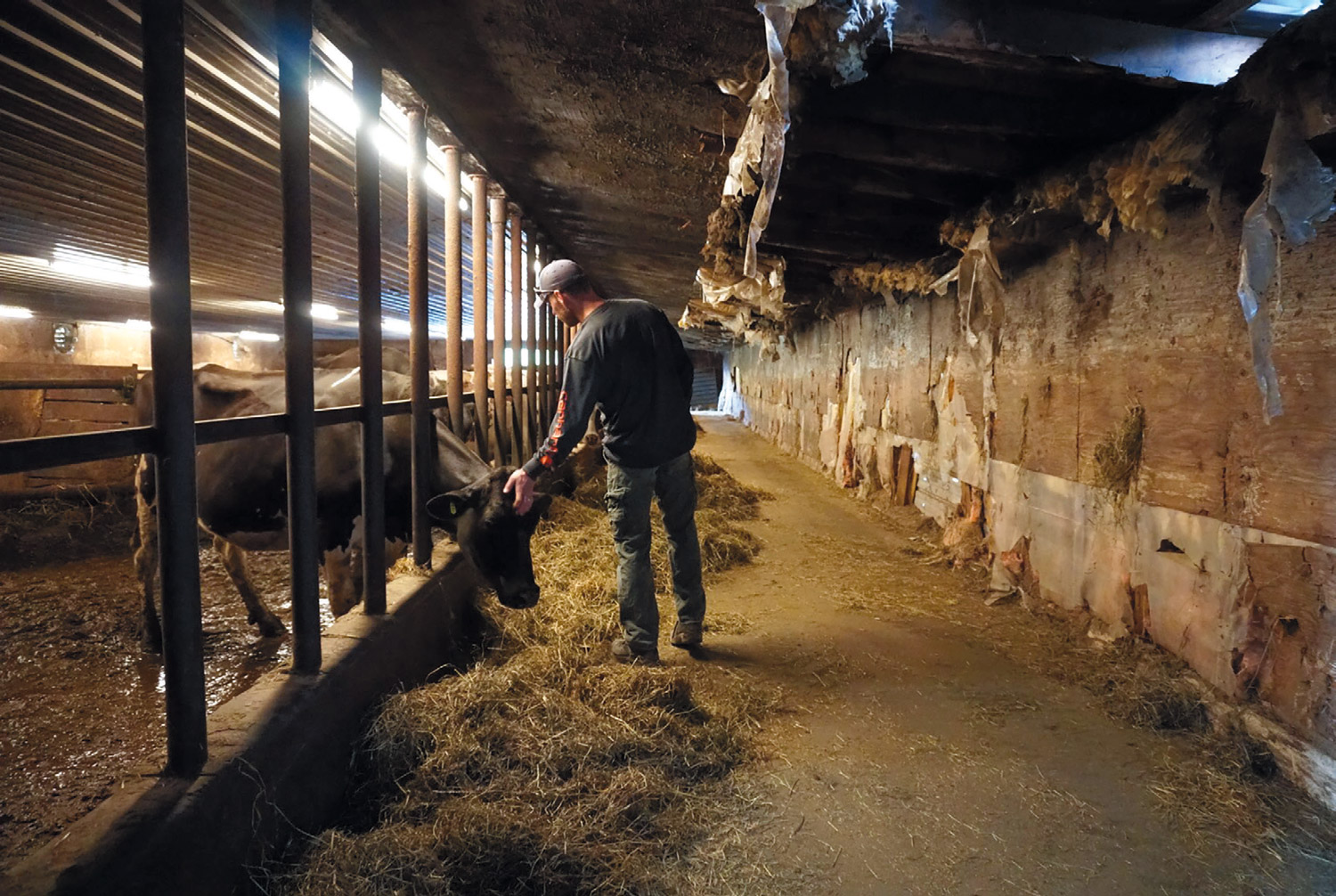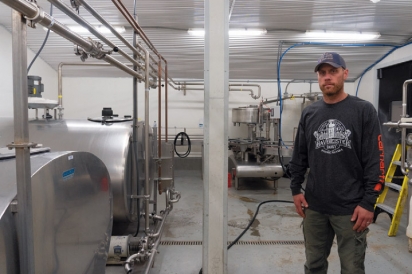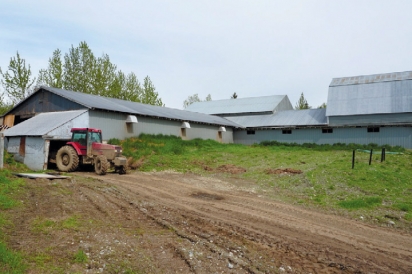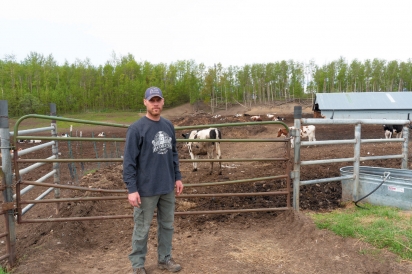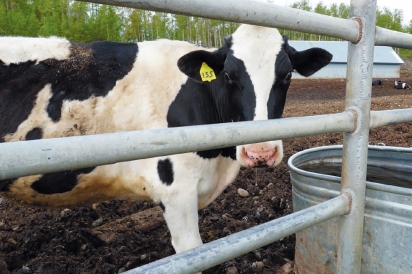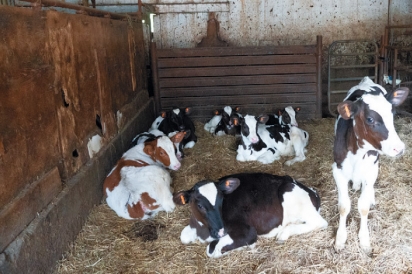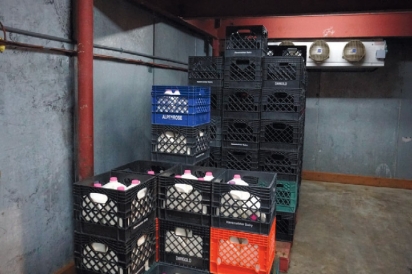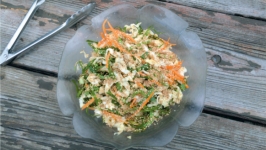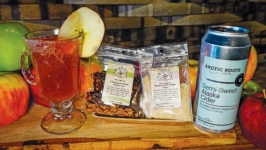The Fight for Alaska Dairy
A look inside Havemeister Dairy, one of Alaska’s last commercial dairies
Brown- and black-spotted cows lounge in a small field outside the Havemeister Dairy barn. The farm outside of Palmer hardly resembles the industrial operations that dominate the dairy industry outside of Alaska. Havemeister Dairy is a small family farm. An Alaska Grown sticker clings to their office window. On a quiet Saturday in early May, nobody staffs the desk inside, but not because they are closed.
You don’t get to be one of the only surviving commercial dairies in the State of Alaska by taking days off. Ty Havemeister hasn’t had a vacation since he started the creamery side of Havemeister Dairy almost a decade ago. Today, he started work at 4 a.m., when he helped his driver load an Anchorage milk delivery. He spent all morning getting one of his hayfields ready for planting. Springtime is busy. Havemeister has had to work every day this week.
And yet, he has the energy to smile warmly and apologize that he’d been hard to reach by phone as he gives a tour of the barn. The cows crane their heads to catch a scratch behind the ears.
“There’s days when any job is trying, but it’s better than sitting in traffic for an hour and a half to commute to Anchorage,” he says.
Havemeister’s work ethic runs in the family. His 79-year-old father Bob Havemeister is up at 6 a.m. every day working on the farm. He has no plans for retirement. “He’ll stop when he stops breathing,” Ty Havemeister says with a laugh.
The Havemeisters’ success is a cocktail of hard work, experience, good business sense, and local support in a state where everything from feed to fertilizer costs twice as much and where the number of commercial dairies has dwindled from double digits to just two since the early 2000s.
“The level of debt on most of the dairy farms in Alaska was greater than what cows could support,” Milan Shipka, a livestock expert and Acting Director of the School of Natural Resources and Extension at the University of Alaska Fairbanks, says. “Combined with losing the only milk processor that many could ship to, that [debt] is what caused the diminishing of our dairy [industry].”
People drink less milk than they used to, too. Barriers like cost of land, available equipment, and a lack of local dairy knowledge have meant few have tried to enter the industry since it has contracted so dramatically. Luckily for Havemeister, dairy runs in his blood.
His grandparents opened Havemeister Dairy in 1935. Back then, they weren’t alone. Drought and poverty in the upper Midwest led President Theodore Roosevelt to experiment. The federal government sent more than 200 families north to the fertile soils of the Matanuska Valley. They called it the Matanuska Colony, and it put Palmer on the map as an agricultural economy.
The Havemeisters had never really farmed before. They started with one cow.
“I think they saw an opportunity to try and build a new life and took it,” Havemeister says.
Bob Havemeister took over the farm when he was in high school, after his father died young. He grew the operation to around 160 cows and 5,000 gallons of milk production a week, on average. The dairy now employs six people, and they pasteurize, bottle, and deliver their own milk.
They even grow their own hay.
“We do everything. It goes from the cow to the table,” Ty Havemeister says. “It’s pretty special.”
Surprisingly, the legacy Havemeister is carrying on isn’t something he thinks about much. He’s too busy making sure the milk makes it to store shelves. But family legacy is part of what inspired him to return to the family business after working in Florida as a financial advisor and stockbroker.
“I have two daughters, nine and six,” he says. He wanted them to grow up on a farm like he did. He wanted them to learn the value of hard work and to know where their food comes from. “Here they see the life cycle, they learn life and death at a young age… It’s something you can’t teach in a book.”
Havemeister also returned out of necessity. Havemeister Dairy used to sell their milk to Matanuska Creamery, which processed, bottled, and sold it for them. In 2012, though, the creamery closed after failing to make payments on state loans.
The year before, Havemeister Dairy decided to open their own creamery instead. They could see that Matanuska Creamery was struggling, and they wanted to make sure they had a way to process their milk. “Nobody was getting paid fully for product, which is why we built this,” Havemeister says.
Havemeister Dairy spent $500,000 on equipment and worked through the complicated steps to get their creamery Grade A certified. Without that federal certification, they couldn’t sell in stores.
Next, they had to build connections with stores and convince corporate offices in faraway cities to open up precious shelf space.
“If the demand isn’t there, you’ll be gone,” Havemeister says.
But the demand is there. The dairy now sells all over Anchorage and the Matanuska-Susitna Valley in grocery stores and coffee shops. This week, the walk-in cooler is mostly empty. They’re short on milk. Havemeister says it happens sometimes because of a gap in calving. Their facilities are maxed out.
People are thirsty for local dairy.
Which is why when Governor Mike Dunleavy’s Administration attempted to cut the state’s dairy inspection program in March—a decision that would’ve spelled the end of Havemeister’s operation—the program didn’t die quietly.
Havemeister, along with Phillip Schneider of True North Plastics, the company that makes Havemeister Dairy’s milk jugs, started talking to state representatives in Juneau.
“They all had a stack of Havemeister Dairy e-mails,” Havemeister says, “[from] people who were angry.”
Just One More Hurdle
Stainless steel equipment gleams inside the creamery. The machinery is quiet, but three days a week, it hums for ten hours straight, while Havemeister and two other employees work mechanically to safely turn raw milk into a pasteurized, bottled product.
“It’s funny because whether you run 200 gallons or 2,000 gallons, cleaning takes all the time,” he says.
Once a month, the state’s dairy inspection program pulls samples of Havemeister Dairy’s pasteurized milk. The dairy sanitarian visits regularly to inspect their cows and facilities. Havemeister Dairy doesn’t pay for the federally mandated inspections.
“If you can’t get inspected, from the Fed’s eyes you’re no longer Grade A, which means you can’t sell milk on the shelf,” Havemeister adds. “You’re kind of done at that point. You can’t even hire a third party to do it.”
He found out about the threats to the state’s dairy inspection program mostly through media reports. Suddenly, reporters were calling with questions, and he realized that his family’s three-generation investment might disappear within the year if the governor’s proposed budget passed: just one more hurdle in an already tough industry.
“Depending on what happens with the governor and inspections and everything else, we’ll be the last dairy of any size in the state,” Havemeister says. “Once we’re gone, you’re never going to get it back.”
The budget proposal included deep cuts to programs across departments, from agriculture to education to transportation. The dairy inspection program, which currently has only one active participant, may have seemed like an obvious option for cutting state spending on.
“The truth of the matter is, the budget’s been cut a lot. There’s not many places to cut,” says Democratic Representative Geran Tarr, an advocate for local agriculture.
But the elimination of the state’s dairy inspection program would have impacted more than just one business. At the time, there were two other dairies looking at certification, a bovine dairy in Delta Junction and a goat dairy on Kodiak. Kodiak Baptist Mission’s Heritage Farms has since been approved to sell goat’s milk cheese and ice cream.
Havemeister Dairy also buys products from local businesses, like their milk jugs and barley, and they sell cows to people in their community.
“The significance of those farms is not just providing foods for local food production,” says State Veterinarian Dr. Robert Gerlach, whose office oversees the dairy inspection program. “They are tied in economically to a large number of other businesses, and that has a significant impact on local economies.”
The economic impact of Alaskan agriculture pales in comparison to bigger industries like oil and gas and tourism. But for Havemeister, the importance of local dairy isn’t just about money. It comes down to quality.
“Milk from down south is a week old by the time it gets here,” he says. “We have [our milk] on the shelf within two days of putting it in the jug.”
There is one option for operating a dairy without Grade A status. A few dairies in the state distribute raw milk through herdshare programs. Customers buy into the farm’s milking herd and pick up the products themselves. It’s a good solution for small herds, or for people looking for a stepping stone before investing the money and time it takes to get certified, but it doesn’t work for everybody.
“In that type of program, it’s a limited number of customers,” Gerlach says. “A large dairy trying to make a business can’t do it.”
Safety is another raw milk concern. The whole reason the government regulates dairy is to protect consumers from contamination and bacteria.
“It’s such a high-risk product with respect to foodborne illness,” Gerlach adds.
If the dairy inspection program shut down, that would close the door to future growth and make Alaska the only state without a program. That’s one of the reasons Tarr decided to take action. “It’s part of our heritage,” she says.
After receiving countless e-mails and phone calls, Tarr and Republican Rep. DeLena Johnson introduced an amendment with the support of others to protect the program’s funding in April. For now, the public outcry has paid off. Thanks to a House amendment and Senate approval, the program—and Havemeister Dairy—are safe, but they’ll likely have to pay for inspections in the future, a hard pill to swallow in an already expensive industry. The dairy program did survive a veto from the governor in June, unlike other agricultural programs like Alaska Grown. But there’s always next year.
“If every single year you’ve got to go and become a politician for three months just so that you can work from 4 a.m. to 7 p.m., it seems like that’s maybe not something you want to do every year,” Havemeister says.
But he’s not dwelling on that possibility. Havemeister thinks the political headwinds are behind them. His family has hayfields to tend to, cows to milk, milk to bottle, and customers to feed. He said he has no regrets.
“You can’t look back. It’s been really good to us. It’s been good to my family, great for our farm. We’ve had amazing support,” he says. “It felt good that people cared enough to take time out of their day and send an e-mail to their representative and make a phone call, write a letter.”
Havemeister smiles and looks back to the field.
“I guess it’s time to get back to work.”


